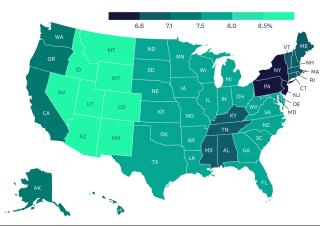Precision pricing: How retailers should act on inflation data

The data is not monolithic. Retailers should understand inflation trends more granularly.
Bloomberg recently reported that American consumers are starting to hit their breaking point. The article looked at waning consumer sentiment throughout the US, and the impact that general inflation levels have had on these sentiments. Will U.S. businesses – say in retail – suddenly and uniformly need to adjust prices? Or is there a more granular approach that provides retailers with a more precise solution to optimizing prices?
Getting this right is a very big deal. Whether you are a global retailer or focused on a single country or region of that country, a blunt approach to changing prices could chip away from already shrinking profit margins.
Thinking globally, a first step is to understand how inflation varies country by country. The inflation rate might have a lot of utility for policymakers, at the global and country levels. But it might also, accidentally, provide false comfort to retailers, as a drop in inflation is predicted this year, coming off a very bad 2021.
Inflation is not monolithic
The fact is, according to The Advisor Channel, country-by-country rates show wide disparities, including South America, where inflation has shot up by fifty percent. This could be anomalous, however, because for Argentina, inflation has become a way of life. That said, for retailers, there cannot be a monolithic Latin American strategy for inflation-driven pricing.
Most interestingly, within most continents we see divergence. In South America, the northern countries resemble what’s happening in North America. But in the south – Argentina’s chronic, legendary inflation is a big outlier.

But why stop at country-by-country data, where there is data available, region by region, or, as in the U.S., state-by-state. If you look across the U.S., you will see that inflation has surged in the mountain states while the middle of the country, including Texas and the Southeastern coastal states are both experiencing higher rates than on the East and West coasts.
I have to ask again, why stop there? One, of course, could look at the data county by county or city by city.
The reality about inflation data is that it’s not just geographically diverse. One can, and should slice and dice the data in all sorts of ways: demographically, by gender, age, ad infinitum. It would be difficult for a retailer to do this itself. What’s required is a data platform that is real-time so that the retailer can be responsive and conduct pricing with greater precision, and predictability.
Why responsive in real-time? Another reality is that the numbers change constantly. No sense navigating pricing options if the data you are using comes monthly or quarterly. Same day data can enable pricing that is immediately responsive to the needs of the shopper.
Why with greater precision? As I noted earlier in this piece, precision could preserve and even increase margins where other retailers might lose margin. Again, inflation is not monolithic. A granular approach is required to grow and earn greater share-of-wallet.
Why predictability? To win against inflation requires that retailers be able to look out the windshield instead of the rear-view mirror. This is a game of time, where the retailer with advanced AI can help predict customer behavior, giving the retailer a structural onramp to the future. This is the age of AI, and the retail industry is coming to embrace it.
AI is the answer
Because retailers can’t rely on government and research groups to come up with real-time, granular data, the organization has to do the work itself, and it can only be done with advanced artificial intelligence (AI) technology. This enables the retailer to leverage the data it has gathered to automate the tasks it cannot efficiently do with labor, and free up that labor on higher-value activities to better serve customers. It’s becoming the new mantra in retail AI. It enables retailers to make decisions based on fresh and relevant facts, not human bias. Humans have a higher role in the equation.
But if that’s not enough to persuade a retailer to go granular in pricing and personalization, take the case of Amazon, which has been continuously developing this capability since it first launched nearly three decades ago. Talk about an onramp. Fortunately, for retailers, there are practical technologies they can use to become more Amazon-like when it comes to pricing.





